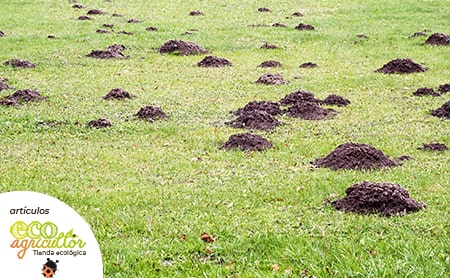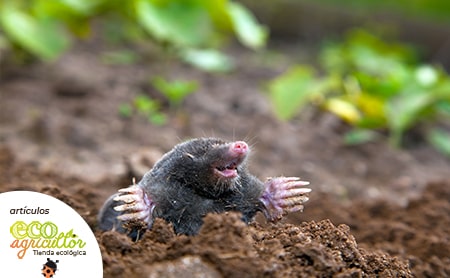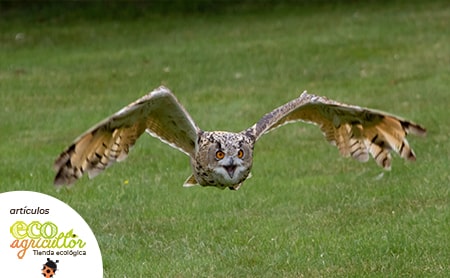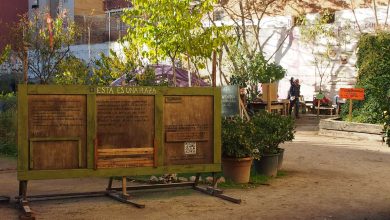MOLES: Ecological Remedies to Drive Away This Plague from Orchards and Gardens

The moles are considered, along with the rabbits, voles and voles, the pests of mammals vertebrates of gardens and orchards. These animals can become a nuisance, not just because of what they eat, but because of the holes and burrows they dig and the diseases they can carry and transmit.
In this post we will tell you which ecological solutions are the most useful so that you can put them into practice in case of having a mole plague.
What are moles?
They are subterranean mammalian animals that belong to the Talpidae family .
They are small, weighing approximately 100 grams and are about 16 cm long from snout to tail. Their hair color can range from black to light brown. It should also be noted its legs are strong (and especially the front ones) and wide to dig easily. The sense of hearing is highly developed and the sense of smell as well, while that of sight is the most limited.
It is quite common for mole pests to occur in orchards and gardens where they dig tunnels underground to access plant roots. In the case of gardens, they can also feed on root vegetables (carrots, radishes, etc.) and tubers (potatoes, sweet potato, etc.).
What to do at the first signs?
To follow an effective treatment against garden and orchard pests, it is important to consider three essential steps:
-
Identify the pest
As with any orchard or garden affectation, the first thing is to identify what type of pest or disease is the one that you want to control.
To recognize the presence of moles, the main signals will be tunnels, molehills and burrows (in the image below). They leave mounds of fresh, fine earth, generally crescent-shaped, on the surface of the ground.
The species of moles present in the Iberian Peninsula are, mainly, the European mole ( Talpa europaea ) and the Iberian mole ( Talpa caeca occidentalis ), similar in size and eating habits but, the second of them, endemic to the peninsula.
They have a cylindrical and compact body, with forelimbs much more developed than the hindquarters, strong and shovel-shaped, with large and strong flattened nails. In total, from head to tail, adults can measure between 18 and 30 cm, weighing 80 to 120 grams.
The tail is short, 1 to 2 cm, and is sparsely covered with hair, so its scaly skin can be seen there. On the rest of the body the coat is dense, generally black, although it may have a bluish-brown tinge.
Moles are perfectly adapted to subterranean life, they lack an auricle and have a narrow, pointed, pinkish-toned snout with sensitive vibrissae, being very sensitive to vibrations in the ground and to auditory stimuli, this being, together with the developed smell, allowing them to hunt their prey and avoid predators.
The main difference between the two species is in the eyes. While in the Iberian mole they are hidden under the skin, in the European mole, despite being very small, they are visible.

-
Assess the problem
Once the type of mammal whose presence stands out in the garden or orchard has been identified, it is important to determine if the damage it causes is enough to try to control it.
Moles feed primarily on earthworms, insect larvae, rocketworms, shells, centipedes, millipedes, crickets, mollusks, and other invertebrates.
Their galleries are between 5 and 30 cm deep, although they can dig a little deeper, up to about 70 cm. The shallower tunnels are for foraging, the deeper ones connect with the burrow and the tunnel system that in turn connects with the territory of other moles.
They need moderately deep soils, with moist and not too compact soil, rich in the aforementioned foods. For this reason, moles are powerful bioindicators of the health of soils , since they are also very sensitive to environmental pollutants and live only where food is available.
In addition to the impoverishment and degradation of soils, the human being is the mole’s main threat, since it has accused it of damaging crops and gardens when developing its galleries, even though, in reality, its activity can be beneficial .
Moles mobilize soil from deep layers, promote soil regeneration and allow aeration of the land, in addition to eliminating a considerable amount of invertebrates that can be harmful to crops.
-
Available and acceptable options to deal with the problem
As it is an animal that is difficult to see, the strategies to control its presence are usually extremely aggressive, even at the risk of affecting the safety of the rest of the inhabitants and users of the garden.
Toxic baits, traps and fumigation are not recommended methods, not only because they have a great possibility of being ineffective, but also because they are dangerous for humans in contact with this space and through the products that are extracted from there for food. , including spices and aromatics.

Ecological Control of Mole Plagues
Natural solutions to keep moles at bay include:
1. The method of exclusion
The aim is to prevent these mammals from entering the area in question. It consists of placing a wire mesh 60 cm deep around the area to be protected and having a height of at least 30 cm above the surface.
It is a method that is effective when you want to protect an orchard or some individual plants from moles, and it can even be effective to prevent the access of other animals to that area.
2. Repellent devices
The scavenging devices that are installed as stakes in the ground, some ultrasonic, others vibrating and even the decorative pinwheels.
The bottles reused to exert vibration have reported effective results, being a homemade and simple way to drive away moles. They are very easy to place: in each mole we place a metal bar and put a glass bottle upside down on top. Moles are very sensitive to vibration and the one produced by the glass bottle in contact with the iron bar bothers them and they will avoid it by leaving.
3. Vegetable preparations
There are two preparations that stand out for their effectiveness:
- Garlic and cayenne: marinate a level tablespoon of cayenne, a head of garlic (unpeeled) in 1 liter of vegetable oil for 15 days. After this type, remove the garlic and add a tablespoon of soap. Apply by spray on the molehills. Be careful, this remedy can be harmful to your pets and children!
- Castor oil: prepare a mixture with 1 part of castor oil, another equal part of water and add 2 tablespoons of soap. Apply by spray on the molehills.
4. Repellent plants
Include plants of the following species in the orchard or garden:
- Euphorbia Lathyrus , known as spurge or gorse grass
- Fritillaria imperialis , known as imperial crown
- Incarvillea delavayi , known simply as incarvillea.
Very effective, plant them around the crops you want to protect. They are a true plant shield against mole pests and also against mice. It may be the solution that works best in the long term.

5. Natural predators
Achieving the conditions for the presence of natural predators is an effective alternative to limit the abundance of moles, as well as shrews, voles, rabbits, mice and voles.
Some studies have revealed that there seems to be a relationship with the mole rat ( Arvicola terrestrial ), which colonize the galleries excavated by the moles instead of digging their own, facilitating the establishment of new colonies.
The predators of most vertebrate field pests are birds, such as the owl and owl , while foxes, cats and other mammals, although they do manage to capture the moles, do not eat them because the epithelial glands they cause an unpleasant taste.
To increase the presence of species such as the barn owl ( Tyto alba ), the owl ( Athene noctua ) or the harrier ( Circus cyancus ), which can capture from 2 to 10 prey per day, nest boxes are installed on poles of between 4 and 5 meters high, with the entrance facing southeast and avoiding the prevailing winds in the area.
Snakes and weasels are also predators allied to agriculture, especially in the control of vertebrate pests, so it is important to help them find a way to get away from the garden area without killing them.
Bibliography
- “Let’s talk about Gardening. Vertebrate Garden Pests, ”Cheryl Wilen, Integrated Pest Management Consultant, University of California Cooperative Extension. 2003
- «Talpa occidentalis, Iberian mole», Atlas and Red Book of the Terrestrial Mammals of Spain.
- «European mole – Talpa europaea Linnaeus, 1758″, Ma. Carmen Hernández. Zoology Unit, Department of Biology, Autonomous University of Madrid. Encyclopedia of Spanish Vertebrates, National Museum of Natural Sciences. 2016
- «Topo Iberico – Talpa occidentalis Carera, 1907″, Ma. Carmen Hernández. Zoology Unit, Department of Biology, Autonomous University of Madrid. Encyclopedia of Spanish Vertebrates, National Museum of Natural Sciences. 2016
- «Biological control of the plague of voles», Carlos Cuéllar Basterrechea, Alfonso Paz Luna and Javier Viñuela Madera. Group for the Rehabilitation of Native Fauna and its Habitat. 2018

![Photo of Plant Camellias in your Garden: [Where, How and When to do it]](https://www.complete-gardening.com/wp-content/uploads/2022/08/plant-camellias-in-your-garden-where-how-and-when-to-do-it-390x220.jpg)
![Photo of Clavelina Cuttings: [Concept, Period, Rooting and Planting]](https://www.complete-gardening.com/wp-content/uploads/2022/08/clavelina-cuttings-concept-period-rooting-and-planting-390x220.png)

![Photo of Precision Agriculture: [Concept, Uses, Examples]](https://www.complete-gardening.com/wp-content/uploads/2022/08/precision-agriculture-concept-uses-examples-390x220.png)